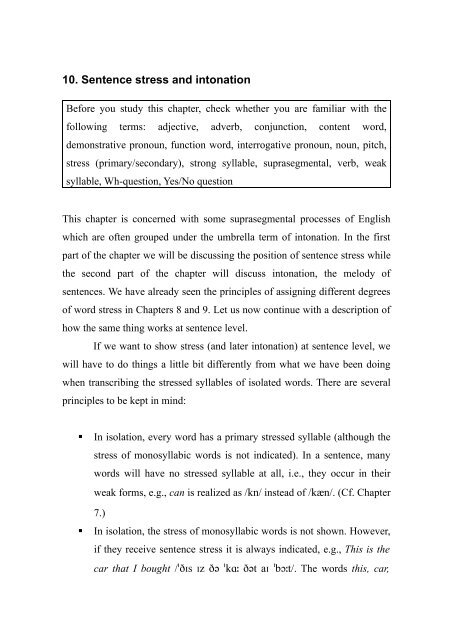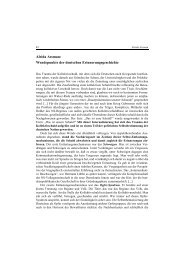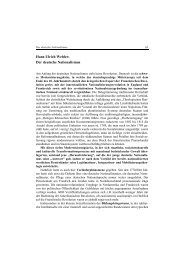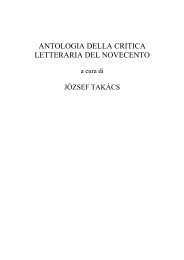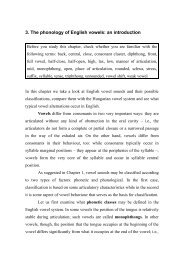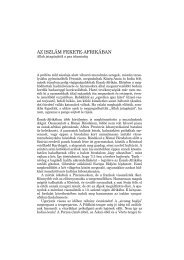10. Sentence stress and intonation
10. Sentence stress and intonation
10. Sentence stress and intonation
Create successful ePaper yourself
Turn your PDF publications into a flip-book with our unique Google optimized e-Paper software.
<strong>10.</strong> <strong>Sentence</strong> <strong>stress</strong> <strong>and</strong> <strong>intonation</strong><br />
Before you study this chapter, check whether you are familiar with the<br />
following terms: adjective, adverb, conjunction, content word,<br />
demonstrative pronoun, function word, interrogative pronoun, noun, pitch,<br />
<strong>stress</strong> (primary/secondary), strong syllable, suprasegmental, verb, weak<br />
syllable, Wh-question, Yes/No question<br />
This chapter is concerned with some suprasegmental processes of English<br />
which are often grouped under the umbrella term of <strong>intonation</strong>. In the first<br />
part of the chapter we will be discussing the position of sentence <strong>stress</strong> while<br />
the second part of the chapter will discuss <strong>intonation</strong>, the melody of<br />
sentences. We have already seen the principles of assigning different degrees<br />
of word <strong>stress</strong> in Chapters 8 <strong>and</strong> 9. Let us now continue with a description of<br />
how the same thing works at sentence level.<br />
If we want to show <strong>stress</strong> (<strong>and</strong> later <strong>intonation</strong>) at sentence level, we<br />
will have to do things a little bit differently from what we have been doing<br />
when transcribing the <strong>stress</strong>ed syllables of isolated words. There are several<br />
principles to be kept in mind:<br />
In isolation, every word has a primary <strong>stress</strong>ed syllable (although the<br />
<strong>stress</strong> of monosyllabic words is not indicated). In a sentence, many<br />
words will have no <strong>stress</strong>ed syllable at all, i.e., they occur in their<br />
weak forms, e.g., can is realized as // instead of //. (Cf. Chapter<br />
7.)<br />
In isolation, the <strong>stress</strong> of monosyllabic words is not shown. However,<br />
if they receive sentence <strong>stress</strong> it is always indicated, e.g., This is the<br />
car that I bought / /. The words this, car,
<strong>Sentence</strong> <strong>stress</strong> <strong>and</strong> <strong>intonation</strong><br />
bought are <strong>stress</strong>ed in the sentence as indicated by the <strong>stress</strong> marks<br />
although they are all monosyllabic words.<br />
To be able to cope with the assignment of sentence <strong>stress</strong> <strong>and</strong>, on the<br />
basis of that, <strong>intonation</strong>, we have to clarify a few important basic notions.<br />
One of the distinctions we have to make is between lexical/content words<br />
<strong>and</strong> grammatical/function words. The former include the four basic<br />
categories, nouns, verbs, adjectives <strong>and</strong> adverbs – including adverbial<br />
particles like up – while the latter contain the rest of the categories,<br />
prepositions, pronouns, auxiliaries, conjunctions. Also, some minor<br />
categories can be compared to one of these two groups: demonstrative <strong>and</strong><br />
interrogative pronouns, e.g., this, that <strong>and</strong> what, where respectively, are<br />
<strong>stress</strong>ed like content words.<br />
In the case of word <strong>stress</strong> we identified different degrees of <strong>stress</strong> in<br />
Chapters 8-9, we may do so in sentences, too, <strong>and</strong> just like in words, in<br />
sentences it is also the last <strong>stress</strong> that is the strongest. That is, the strongest<br />
<strong>stress</strong> of a sentence falls on the last <strong>stress</strong>ed syllable, which is called the tonic<br />
– sometimes also called accent, nucleus or sentence <strong>stress</strong>, indicated by<br />
underlining in this chapter. The tonic will have a special role in describing<br />
<strong>intonation</strong> as <strong>intonation</strong> is nothing else but a falling or rising melody starting<br />
on the tonic.<br />
With the help of the tonic we may define some further concepts<br />
relevant for our discussion: speech is divided into so-called tone-units – or<br />
tone groups or <strong>intonation</strong> phrases –, which are parts of connected speech<br />
ending in a tonic. That is, a tone-unit starts after a tonic <strong>and</strong> ends in a tonic.<br />
Tone-units are normally realized by clauses as in the first three examples or<br />
by longer phrases as in the second three examples below. The boundaries of<br />
tone-units are usually indicated by vertical lines.<br />
139
Chapter 10<br />
She wanted to face the problems on Tuesday.<br />
He felt uneasy but the others were enjoying themselves.<br />
I didn't really want to come but here I am.<br />
No way!<br />
At five o'clock.<br />
No, only at the meeting.<br />
Besides the tonic, the tone-unit has the following parts: tail – the un<strong>stress</strong>ed<br />
syllables following the tonic, e.g., -day in the first example above –, the pre-<br />
head – the un<strong>stress</strong>ed syllables before the first <strong>stress</strong>, e.g., she in the first<br />
example –, <strong>and</strong> the head – starting with the first <strong>stress</strong>ed syllable <strong>and</strong> ending<br />
with the last un<strong>stress</strong>ed syllable before the tonic, e.g., wanted to face the<br />
problems on in the first example above:<br />
She wanted to face the problems on Tuesday.<br />
Pre-head Head Tonic Tail<br />
The tone unit may also be divided into other kinds of constituents which play<br />
a very important role in determining the rhythm of the sentence. These units<br />
of rhythm are called feet (cf. Chapter 7), the same name that is used for<br />
rhythmic units in literature to determine the rhythm of poems. As it was<br />
mentioned in Chapter 7, a foot is the sequence of a <strong>stress</strong>ed syllable <strong>and</strong> all<br />
the un<strong>stress</strong>ed syllables following it up to the next <strong>stress</strong>. The sentence above<br />
may be divided into feet the following way:<br />
140
She wanted to face the problems on Tuesday.<br />
foot0 foot1 foot2 foot3 foot4<br />
<strong>Sentence</strong> <strong>stress</strong> <strong>and</strong> <strong>intonation</strong><br />
It is clear that the first foot, foot0 is an incomplete one as it only contains<br />
un<strong>stress</strong>ed syllables – if there is a pre-head, it is always an incomplete foot.<br />
Recall from Chapter 7 that the special characteristic property of<br />
English rhythm is that it is <strong>stress</strong>-timed. It means that the <strong>stress</strong>ed syllables<br />
follow each other at intervals of about the same length, which sounds like a<br />
pulsating rhythm. This means that in the sentence above the time elapsing<br />
between the <strong>stress</strong>ed syllables wan- ... face ...prob ... Tues is approximately<br />
equal although there might be different numbers of un<strong>stress</strong>ed syllables<br />
between them. Since this rhythmic sequence of pulses is very different from<br />
Hungarian, it is something to be practised a lot to get used to pronouncing<br />
(sometimes many) weak syllables between the <strong>stress</strong>ed ones.<br />
When connecting words into a sentence it often happens that there<br />
will be a sequence of three <strong>stress</strong>ed syllables with zero or just one un<strong>stress</strong>ed<br />
syllable between them. In such cases the rhythm becomes jerky, staccato-like.<br />
To avoid such <strong>stress</strong> clusters the middle one of the three <strong>stress</strong>es is deleted<br />
<strong>and</strong> the syllable is pronounced as un<strong>stress</strong>ed, a process called Rhythmic<br />
Stress Deletion – this deletion of <strong>stress</strong> is indicated with a superscript zero in<br />
the examples:<br />
good old days → good 0 old days<br />
very brave soldier → very 0 brave soldier<br />
cover the big news → cover the 0 big news<br />
141
Chapter 10<br />
In cases when a word with two <strong>stress</strong>es is followed by a word <strong>stress</strong>ed on the<br />
initial syllable it would result in three <strong>stress</strong>ed syllables in a row. As a result,<br />
rhythmic <strong>stress</strong> deletion will delete the <strong>stress</strong> in the middle. This way the<br />
<strong>stress</strong> pattern of the first word has been changed as the primary <strong>stress</strong> has<br />
shifted to the left from the last syllable, a process called Rhythmic Stress-<br />
Shift:<br />
the best man asked // → the best 0 man asked //<br />
a stone deaf guy // → a stone 0 deaf guy //<br />
a dark brown hat // → a dark 0 brown hat //<br />
As is clear from the above, this may affect finally-<strong>stress</strong>ed compounds <strong>and</strong><br />
longer words ending in two <strong>stress</strong>ed syllables in a way that they will have<br />
two slightly different <strong>stress</strong> patterns depending on whether the next word<br />
starts with a <strong>stress</strong>ed or un<strong>stress</strong>ed syllable. Before words starting with an<br />
un<strong>stress</strong>ed syllable nothing happens, but before words starting with a <strong>stress</strong>ed<br />
one the final primary <strong>stress</strong> of the first word shifts one to the left.<br />
In the following we take a look at the two major types of tonic<br />
placement. The first type of tonic placement is the neutral, unmarked or<br />
default type: it does not express emphasis or contrast. This is called neutral<br />
tonic placement or neutral tonicity. The neutral tonic is normally placed on<br />
the last content word but in some exceptional cases it may fall on an earlier<br />
content word or on a function word.<br />
Tonic on last content word<br />
Everyone was there<br />
We didn't want to talk about the details.<br />
142
He was finally admitted to university.<br />
<strong>Sentence</strong> <strong>stress</strong> <strong>and</strong> <strong>intonation</strong><br />
Tonic on an earlier content word (the skipped last content word italicized)<br />
He bought a new mountain bike. No tonic on 2 nd part of initially<br />
<strong>stress</strong>ed compound.<br />
It was nice, I think. No tonic on afterthoughts, appended<br />
remarks.<br />
We'll just stay here. No tonic on common adverbs.<br />
That's what the book says. No tonic on "obvious predicates".<br />
Tonic on a function-word<br />
No, you can't. Tonic on an auxiliary if no other<br />
<strong>stress</strong>able word.<br />
Where are you from? Tonic on Prep in short sentences<br />
without main verb.<br />
This is mine Tonic on possessive pronoun.<br />
In the second major type of tonic placement the speaker wishes to emphasize<br />
some part of the utterance, contrast a part of it with something or focus on<br />
some new information, which may be achieved by placing the tonic at a<br />
different place from where it would normally appear. The following two<br />
sentences demonstrate that while the first sentence with neutral tonic<br />
placement on the last content word does not emphasize or contrast any part of<br />
the sentence, the second sentence with so-called dislocated tonic does.<br />
Jim was there. Jim was there.<br />
143
Chapter 10<br />
As the underlining indicates, there has the tonic in the first sentence while<br />
Jim has the tonic in the second. Accordingly, the first sentence has a neutral<br />
interpretation, while the second sentence emphasizes that it was Jim who was<br />
there, not somebody else. Let us now take a look at what might be the<br />
reasons for having a dislocated tonic in a sentence.<br />
Contrast<br />
In many cases the tonic is placed on an earlier content word to express<br />
contrast between what has been said <strong>and</strong> the word/expression bearing the<br />
tonic. The two most common cases are when either it is a particular lexical<br />
item, a certain word that we want to contrast with another one, e.g., a name<br />
with another name, or negative polarity with positive polarity, i.e., negation<br />
with assertion. If a word is contrasted, it is indicated in capital letters.<br />
I gave JACK that book on history yesterday. ... <strong>and</strong> not somebody else.<br />
We visited a lot of MU SEUMS<br />
in London. ... <strong>and</strong> not night-clubs.<br />
I HAVE<br />
I DID<br />
seen the film earlier. ... contrary to what you<br />
think/claim.<br />
pass the test. ... although that's not what<br />
New information<br />
you think.<br />
If the end of the sentence contains information the speaker thinks is known<br />
by the listener as old information, then the words describing this old<br />
information will be de-<strong>stress</strong>ed <strong>and</strong> <strong>stress</strong> (<strong>and</strong> the tonic) will be shifted<br />
leftwards to some earlier word considered to carry new information. It most<br />
typically happens in answering questions repeating some words from the<br />
question – the old information skipped by tonic assignment is italicized.<br />
144
Is the book interesting? It is VERY<br />
interesting.<br />
Do you want to have lunch? But I already HAD lunch.<br />
<strong>Sentence</strong> <strong>stress</strong> <strong>and</strong> <strong>intonation</strong><br />
I'm from Hungary. Oh, my FIANCÉE<br />
is Hungarian, too.<br />
So far we have seen which part of a sentence carries the strongest <strong>stress</strong> – the<br />
tonic –, how it relates to the rest of the clause – the tail, the head <strong>and</strong> the pre-<br />
head –, how the head plays a role in determining the rhythm of the clause by<br />
being divided into feet, <strong>and</strong>, finally, how tonic assignment may be performed<br />
in neutral cases <strong>and</strong> in dislocated cases when the speaker wishes to<br />
emphasize or contrast some part of the sentence. Now we turn to how these<br />
units relate to <strong>intonation</strong>, the melody <strong>and</strong> the melody change of a sentence.<br />
The <strong>intonation</strong> or melody of a sentence is the voice-height, or pitch.<br />
On the one h<strong>and</strong>, pitch depends on what kind of <strong>intonation</strong> is used in the<br />
pronunciation of a particular sentence. On the other h<strong>and</strong>, there are also non-<br />
linguistic factors that influence pitch: age – children have a higher pitch than<br />
adults –, sex – men normally have a lower pitch than women –, <strong>and</strong> the<br />
emotional state of the speaker – excited speakers tend to have a higher pitch<br />
than someone in a neutral mood. Every speaker has a limit to how high or<br />
how low a pitch they may produce; these two are the upper <strong>and</strong> lower limits<br />
of one's pitch range. This pitch range is different for each speaker but it does<br />
not influence the underst<strong>and</strong>ability of their speech: it is not the absolute but<br />
the relative pitch height that matters.<br />
Pitch differences do not only occur between speakers but also<br />
between languages. Hungarian, for instance, is said to have a much narrower<br />
pitch range in general than that of English; that is, the highest pitch of an<br />
average native English speaker is higher than that of an average native<br />
Hungarian speaker, while the lowest pitch of an English speaker is generally<br />
145
Chapter 10<br />
lower than that of a Hungarian speaker. This is even noticed by the untrained<br />
ear. For instance, Hungarian speakers often report that they find English<br />
speech too emotional, excited <strong>and</strong> affected; English speakers, on the other<br />
h<strong>and</strong>, find the speech of the average Hungarian – whether this average<br />
Hungarian speaks English or Hungarian – too flat, monotonous or boring.<br />
Intonation is the way the pitch changes in the tone-unit. Recall that<br />
the last <strong>stress</strong>ed syllable of the tone-unit, the tonic always has pitch change,<br />
that is, the speakers' voice will either rise or fall on the tonic syllable. This<br />
change associated with the tonic syllable is referred to as the tone 1 . The<br />
melody of the tone is always continued in the tail of the tone-unit; the tail<br />
will never contain another change in pitch. If we do not only consider the<br />
pitch change realized on the tonic syllable, but rather the pitch changes<br />
occurring throughout the whole tone-unit, we may talk about the tune or<br />
<strong>intonation</strong> pattern of the sentence. In the following we briefly describe the<br />
characteristic properties of the parts of the tone-unit followed by a discussion<br />
of the tones <strong>and</strong> the typical meanings or functions associated with them. The<br />
reader, however, has to be aware that this relationship is not a one-to-one<br />
relationship, so the same communicative function is not always expressed by<br />
the same tone <strong>and</strong> the same tone does not always express the same meaning.<br />
The melody of the pre-head of the tone-unit – if there is one –<br />
normally starts at a relatively low pitch which normally jumps high up on the<br />
first <strong>stress</strong>ed syllable, i.e., on the beginning of the head. The pitch usually<br />
gradually falls throughout the head, which is called downdrift. Since it is not<br />
the pitch change realized on the tonic, it does not count as falling <strong>intonation</strong>,<br />
it is just a natural consequence of the fact that speakers are normally running<br />
out of air <strong>and</strong> this way the velocity of the outflowing air is dropping, which<br />
results in a lower pitch. The part of the tone-unit after the tonic, the tail – if<br />
1 Note that this usage of tone is slightly different from tone in tone languages (cf. the<br />
beginning of Chapter 8).<br />
146
<strong>Sentence</strong> <strong>stress</strong> <strong>and</strong> <strong>intonation</strong><br />
there is one – is normally a simple continuation of the pitch change of the<br />
tonic: if the pitch rises on the tonic, it will slowly, gradually rise on the tail,<br />
too. If it falls on the tonic, then it will fall on the tail, too. This is<br />
demonstrated by the graphic representations below. The arrow before the<br />
tonic syllable indicates the pitch change on the tonic.<br />
He believed that they had seen the movie earlier.<br />
Have you seen this movie?<br />
Let us now take a look at the four types of tone <strong>and</strong> the different functions<br />
associated with them:<br />
Type of tone Name of tone Tone contour Function, meaning<br />
Falling Fall neutral, definiteness, finality<br />
Rising Low rise indifference, encouragement<br />
The falling tone<br />
High rise Yes/No questions, inquiry<br />
Fall-rise old information, implication<br />
The falling tone is the most common, neutral tone used in English. It suggests<br />
that speakers are simply conveying information. As a result, it is most often<br />
used in plain statements, real, serious comm<strong>and</strong>s – as it expresses finality <strong>and</strong><br />
definiteness –, in exclamations – expressing that the speakers are sure of<br />
147
Chapter 10<br />
what they are saying –, <strong>and</strong> in Wh-questions, i.e., questions starting with a<br />
question word (who, what, where, why, how, etc.).<br />
I think we haven't met. This is the house where I grew up.<br />
Leave all the books on the desk! Put the gun on the ground!<br />
What a truly beautiful day! How absolutely fabulous an idea!<br />
How did you know he was my brother? What are you working on?<br />
The low rising tone<br />
The low rising tone is the most difficult for Hungarian learners of English as<br />
in Hungarian it is only used in certain types of questions while in English it is<br />
never used in this sentence type. Instead, it is always used to respond to<br />
something that somebody said. Often it expresses indifference – an "I-don't-<br />
care attitude" –, it is used in apologies, greetings <strong>and</strong> when saying thanks,<br />
<strong>and</strong> also in cases of expressing encouragement.<br />
(How was the film?) It was all right. (Not too bad, not too good.)<br />
(Where shall we go tonight?) We may go to the cinema. (I don't care.)<br />
148
Thank you Excuse me. Bye-bye. You're welcome.<br />
<strong>Sentence</strong> <strong>stress</strong> <strong>and</strong> <strong>intonation</strong><br />
Don't you worry! It doesn't matter. It will be all right.<br />
The high rising tone<br />
The high rising tone is either a high rise on the tonic, if there is no tail, or it is<br />
accomplished on the tonic <strong>and</strong> the tail, if there is one. If there is no tail, i.e.,<br />
the whole high rise is realized on the tonic syllable, then Hungarian speakers<br />
tend to have serious problems with the height: the high rise produced by a<br />
Hungarian speaker is simply not high enough for an English speaker; instead,<br />
it will sound as a low rise, <strong>and</strong> will consequently express indifference or<br />
boredom.<br />
In English, if there is a tail, then the high rise continues from the tonic<br />
throughout the tail <strong>and</strong> is evenly distributed over the syllables of the tonic<br />
<strong>and</strong> the tail. This is also a serious difficulty, if not greater, for Hungarians as<br />
such tonic+tail combinations may not be pronounced with a steady high rise<br />
in Hungarian as the language does not permit a rise on consecutive syllables<br />
within the same tone unit.<br />
In Hungarian there is only a real rise if there is no tail. If there is a<br />
tail, then depending on the number of its syllables, one of the following<br />
things will happen: if the tail consists of just one syllable, it will be a rise-fall;<br />
if the tail has two syllables, the first will rise, the second will fall; finally, if<br />
the tail has more than two syllables, the second last will rise, the last one will<br />
fall. All in all, whenever there is a tail in such Hungarian sentences, it will<br />
have a rise-fall <strong>and</strong> not a steady rise as it does in English.<br />
149
Chapter 10<br />
The high rise is most often used in Yes/No questions, which do not<br />
start with a question word. If something is said with a high rising <strong>intonation</strong>,<br />
it is always a real question.<br />
Have you ever been to Engl<strong>and</strong>? Did you do your homework?<br />
Was it your gr<strong>and</strong>mother? Is Johnny coming to the party?<br />
The high rise is also found in echo-questions, which repeat what a speaker<br />
has previously said.<br />
Where?<br />
You met him at which station?<br />
The fall-rise tone<br />
The fall-rise is a combination of a fall from high or mid tone to low followed<br />
by a low rise, i.e., a rise from low to mid. It is one of the tones that makes<br />
English speech sound too theatrical or affected for the Hungarian ear but it is<br />
not as difficult to learn to do correctly as the high rise or the low rise.<br />
A fall-rise may be used for several purposes: on the one h<strong>and</strong>, it may<br />
indicate that the speaker is not telling everything, but a part of the message is<br />
only implied, the listener has to find it out from the context.<br />
150<br />
I've never seen your flat. (Invite me to see it.)
<strong>Sentence</strong> <strong>stress</strong> <strong>and</strong> <strong>intonation</strong><br />
It may also occur in a sentence made up of two tone-units, the first<br />
expressing old information serving as background for the new information in<br />
the second part of the sentence. The new information is pronounced with a<br />
falling tone.<br />
In our old car there was enough room for six people.<br />
In this chapter we have taken a look at two very important suprasegmental<br />
aspects of English pronunciation: the <strong>stress</strong> patterns of sentences, especially<br />
tone placement on the one h<strong>and</strong>, <strong>and</strong> the basic types of <strong>intonation</strong> <strong>and</strong> their<br />
differences from Hungarian <strong>intonation</strong> on the other.<br />
151


